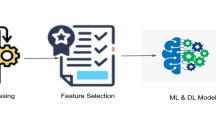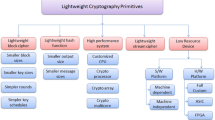Abstract
Authentication is one of the major requirements of wireless networks security, which uses to distinguish legal transmitter from illegal transmitter. Physical layer authentication by taking advantages of channel characteristics has become an effective complement to encryption based authentication methods. In this paper, we propose a machine learning relay assisted authentication for dual-hop multiple-input multiple-output (MIMO) systems with hardware impairments. So far, the multi-hop authentication has not been investigated to identify the transmitter at the receiver. Motivated by this, we use channel features for end-to-end authentication. To implement this technique in the practical systems, channel estimation is implemented in the presence of hardware impairments. The neural network is used to recognize the legitimate transmitter from the attacker in this system. Simulation results show that the proposed method provides a significant improvement in authentication performance using the extracted features with neural network method. Numerical results show that the proposed method presents more than 90% authentication accuracy for both of one-hop and two-hop PLA scenarios.















Similar content being viewed by others
Notes
A, B and E indicate Alice, Bob and Eve, respectively.
References
Wang, N., Li, W., Wang, P., Alipour-Fanid, A., Jiao, L., & Zeng, K. (2020). Physical layer authentication for 5G communications: Opportunities and road ahead. IEEE Network, 34(6), 198–204.
Forouzesh, M., Azmi, P., Kuhestani, A., & Yeoh, P. L. (2021). Joint information-theoretic secrecy and covert communication in the presence of an untrusted user and warden. IEEE Internet of Things Journal, 8(9), 7170–7181.
Angueira, P., Val, I., Montalbán, J., Seijo, Ó., Iradier, E., Sanz Fontaneda, P., Fanari, L., & Arriola, A. (2022). A survey of physical layer techniques for secure wireless communications in industry. IEEE Communications Surveys & Tutorials, 24(2), 810–838.
Hamamreh, J. M., Furqan, H. M., & Arslan, H. (2019). Classifications and applications of physical layer security techniques for confidentiality: A comprehensive survey. IEEE Communications Surveys & Tutorials, 21(2), 1773–1828.
Kazemi, M., Mohammadi, A., & Duman, T. M. (2020). Analysis of DF relay selection in massive MIMO systems with hardware impairments. IEEE Transactions on Vehicular Technology, 69(6), 6141–6152.
Kingston Roberts, M., Kumari, S., & Anguraj, P. (2021). Certain investigations on recent advances in the design of decoding algorithms using low-density parity-check codes and its applications. International Journal of Communication, 34(8), e4765.
Zhang, J., Rajendran, S., Sun, Z., Woods, R., & Hanzo, L. (2019). Physical layer security for the Internet of Things: Authentication and key generation. IEEE Wireless Communications, 26(5), 92–98.
Zou, Y., Zhu, J., Wang, X., & Hanzo, L. (2016). A survey on wireless security: Technical challenges, recent advances, and future trends. Proceedings of the IEEE, 104(9), 1727–1756.
Shahiri, V., Kuhestani, A., & Hanzo, L. (2022). Short-packet amplify-and-forward relaying for the Internet-of-Things in the face of imperfect channel estimation and hardware impairments. IEEE Transactions on Green Communications and Networking, 6(1), 20–36.
Tatar Mamaghani, M., Kuhestani, A., & Behroozi, H. (2021). Can a multi-hop link relying on untrusted amplify-and-forward relays render security? Wireless Networks, 27, 795–807.
Wu, X., & Yang, Zh. (2015). Physical-layer authentication for multi-carrier transmission. IEEE Communications Letters, 19(1), 74–77.
Xie, F., Pang, Zh., Wen, H., Lei, W., & Xu, X. (2022). Weighted voting in physical layer authentication for industrial wireless edge networks. IEEE Transactions on Industrial Informatics, 18(4), 2796–2806.
Bai, L., Zhu, L., Liu, J., Choi, J., & Zhang, W. (2020). Physical layer authentication in wireless communication networks: A survey. Journal of Communications and Information Networks, 5(3), 237–264.
Xie, N., Chen, J., & Huang, L. (2021). Physical-layer authentication using multiple channel-based features. IEEE Transactions on Information Forensics and Security, 16, 2356–2366.
Baracca, P., Laurenti, N., & Tomasin, S. (2012). Physical layer authentication over MIMO fading wiretap channels. IEEE Transactions on Wireless Communications, 11(7), 2564–2573.
Zhang, P., Taleb, T., Jiang, X., & Wu, B. (2020). Physical layer authentication for massive MIMO systems with hardware impairments. IEEE Transactions on Wireless Communications, 19(3), 1563–1576.
Olwal, T. O., Djouani, K., & Kurien, A. M. (2016). A survey of resource management toward 5G radio access networks. IEEE Communications Surveys & Tutorials, 18(3), 1656–1686.
Yu, P. L., & Sadler, B. M. (2011). MIMO authentication via deliberate fingerprinting at the physical layer. IEEE Transactions on Information Forensics and Security, 6(3), 606–615.
Zhang, P., Shen, Y., Jiang, X., & Wu, B. (2020). Physical layer authentication jointly utilizing channel and phase noise in MIMO systems. IEEE Transactions on Communications, 68(4), 2446–2458.
Dong, S., Wang, P., & Abbas, K. (2021). A survey on deep learning and its applications. Computer Science Review, 40, 100379.
Tang, F., Mao, B., Kawamoto, Y., & Kato, N. (2021). Survey on machine learning for intelligent end-to-end communication toward 6G: From network access, routing to traffic control and streaming adaption. IEEE Communications Surveys & Tutorials, 23(3), 1578–1598.
Wang, Sh., Huang, K., Xu, X., Zhong, Zh., & Zhou, Y. (2022). CSI-based physical layer authentication via deep learning. IEEE Wireless Communications Letters, 11(8), 1748–1752.
Qiu, X., Dai, J., & Hayes, M. (2020). A learning approach for physical layer authentication using adaptive neural network. IEEE Access, 8, 26139–26149.
Kumar Kamboj, A., Jindal, P., & Verma, P. (2021). Machine learning-based physical layer security: Techniques, open challenges, and applications. Wireless Networks, 228(4), 5351–5383.
Le, H. D., & Pham, A. T. (2022). Link-layer retransmission-based error-control protocols in FSO communications: A survey. IEEE Communication Surveys and Tutorials, 24(3), 1602–1633.
Du, X., Shan, D., Zeng, K., & Huie, L. Physical layer challenge-response authentication in wireless networks with relay, IEEE INFOCOM 2014 - IEEE Conference on Computer Communications, (2014).
Zhang, P., Zhu, J., Chen, Y., & Jiang, X. (2019). End-to-end physical layer authentication for dual-hop wireless networks. IEEE Access, 7, 38322–38336.
Courville, A., Goodfellow, I., & Bengio, Y. Deep learning, MIT Press, (2016).
Acknowledgements
The authors are gratefully acknowledge the insightful comments of the editor and anonymous reviewers that highly improved the quality of the paper.
Author information
Authors and Affiliations
Corresponding author
Additional information
Publisher's Note
Springer Nature remains neutral with regard to jurisdictional claims in published maps and institutional affiliations.
Rights and permissions
Springer Nature or its licensor (e.g. a society or other partner) holds exclusive rights to this article under a publishing agreement with the author(s) or other rightsholder(s); author self-archiving of the accepted manuscript version of this article is solely governed by the terms of such publishing agreement and applicable law.
About this article
Cite this article
Ezzati Khatab, Z., Mohammadi, A., Pourahmadi, V. et al. A machine learning multi-hop physical layer authentication with hardware impairments. Wireless Netw 30, 1453–1464 (2024). https://doi.org/10.1007/s11276-023-03577-1
Accepted:
Published:
Issue Date:
DOI: https://doi.org/10.1007/s11276-023-03577-1




